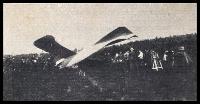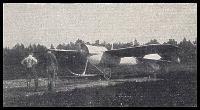O.Thetford, P.Gray German Aircraft of the First World War (Putnam)
Oertz V1 Eindecker
The V1 with a 7-cylinder Gnome of 70 hp was first flown on September 4, 1911 by Ernst Dax. Unfortunately it crashed shortly after on October 21, 1911.
Oertz V2
The Oertz V2 was flown by Wijnmalen on the Luneberger Heide in early February 1912 at the flying field of the Oertz company at Schneverdingen.
Показать полностью
M.Dusing German Aviation Industry in WWI. Volume 2 (A Centennial Perspective on Great War Airplanes 85)
Max Oertz, Jachtwerft, Neuhof-Reiherstieg (Hamburg)
Foundation:
Max Oertz, a builder of high-quality sailing yachts, began designing aircraft in 1909. Later he took over the contract manufacturing of some Wright biplanes for the Berlin company, which in return provided the distribution of the monoplane designed by Oertz.
Max Oertz designed his first powered aircraft as early as 1909, and the first closed aerodynamic fuselage in 1911. Max Oertz designed several flying boats for the Navy and maintained his own airfield in Schneverdingen for test flights. Most of the known aircraft were flying boats, of which the Oertz W6 Flugschoner was particularly striking, a tandem biplane with an additional conventional tailplane and double rudder. The two Maybach engines were housed in the elegant boat hull and drove the propellers via long-distance shafts. Prince Heinrich of Prussia supported him, and the Reichs-Marine-Amt (RMA) also took over some flying boats.
But around 1917, the company was incorporated into the “Hansa-Brandenburg” company.
Aircraft Development:
Max Oertz’ designs also included aircraft and self-stabilizing captive balloons. For the Zeppelin, Oertz designed a so-called spotting basket, which could be roped down from the military airship sailing above the clouds on a long rope to below the cloud cover for observation purposes.
From “Flugsport 1979”: Above all, the Oertz Works were not laid out as quantity production works but were used to meet the special requirements of yacht construction by scientific investigation into the smallest mechanical details, and to devote an absolutely loving care to workmanship and finish.
These fundamental facts, which were reflected in all new productions of this scientifically working factory, whether boats or flying machines, could already be noticed in the very first machine built in 1910. This was a land machine, a monoplane with monocoque body, which weighed only 770 lbs., and, fitted with a 70 hp Gnome engine, reached a speed of 80 m.p.h.
<...>
Показать полностью
Журнал Flight
Flight, October 9, 1919.
THE OERTZ FLYING BOATS
<...>
"Among the most successful, and, therefore, most noteworthy, flying boats, are those designed by D. Ing. Max Oertz, which were built at the Oertz Works at Hamburg. Dr. Oertz, the famous yacht and motorboat builder, was one of the first in Germany to realise the possibilities of flying and the suitability of his works, with their special facilities and trained workmen specialists, for the requirements of aircraft construction. Above all, the Oertz Works were not laid out as quantity production works, but were used to meet the special requirements of yacht construction by scientific investigation into the smallest mechanical details, and to devote an absolutely loving care to workmanship and finish.
"These fundamental facts, which were reflected in all new productions of this scientifically working factory, whether boats or flying machines, could already be noticed in the very first machine built in 1910. This was a land machine, a monoplane with monocoque body, which weighed only 770 lbs., and, fitted with a 70 h.p. Gnome engine, reached a speed of 80 m.p.h. This first success encouraged Oertz to return to his proper element, the sea, and to apply the same principles to the construction of a flying boat; this was ordered by the Navy in the spring of 1913.
<...>
Показать полностью





